外研版(2019) 选择性必修第一册 Unit 6 Nurturing Nature Starting out & understanding ideas课件(31张)
文档属性
| 名称 | 外研版(2019) 选择性必修第一册 Unit 6 Nurturing Nature Starting out & understanding ideas课件(31张) | 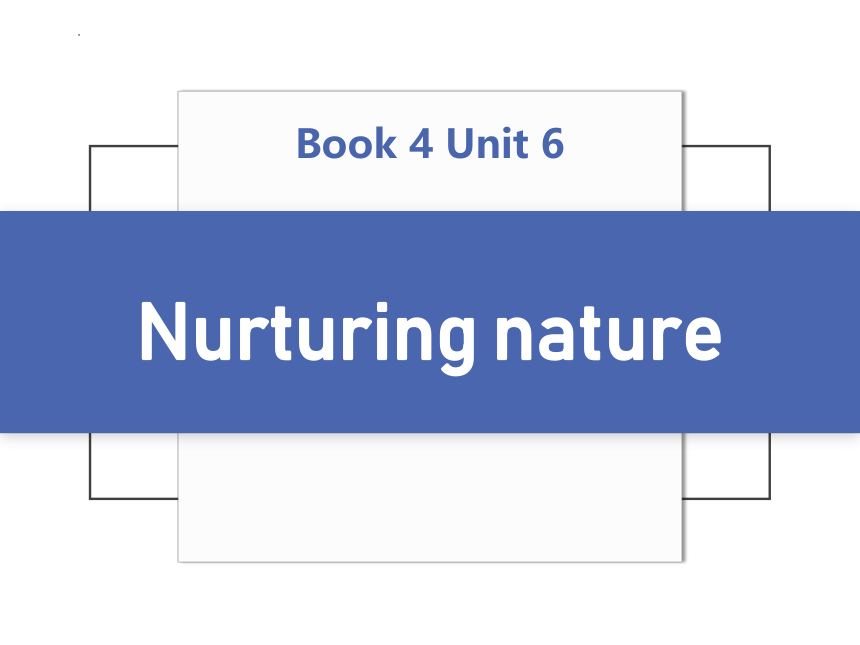 | |
| 格式 | pptx | ||
| 文件大小 | 20.1MB | ||
| 资源类型 | 教案 | ||
| 版本资源 | 外研版(2019) | ||
| 科目 | 英语 | ||
| 更新时间 | 2022-09-29 21:53:19 | ||
图片预览


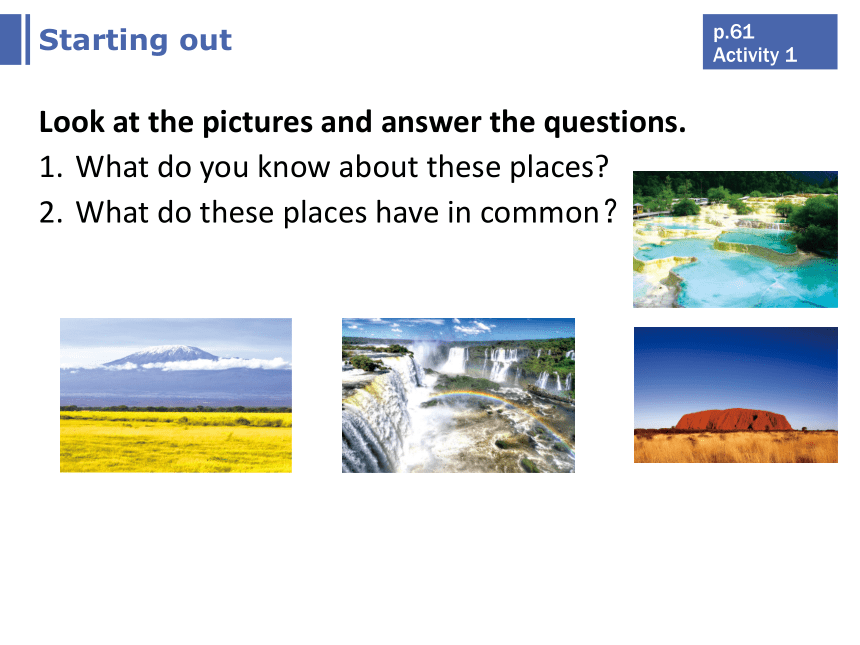
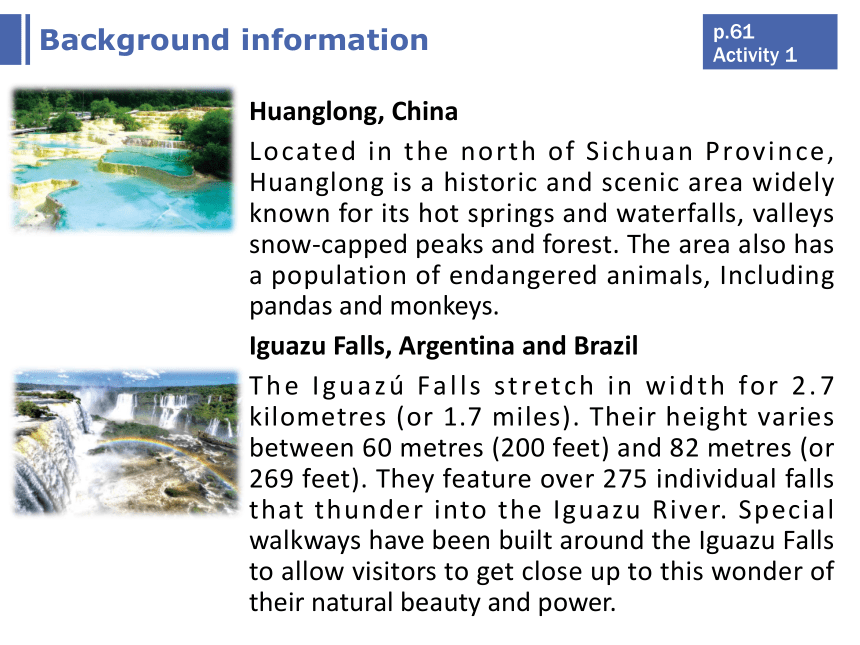
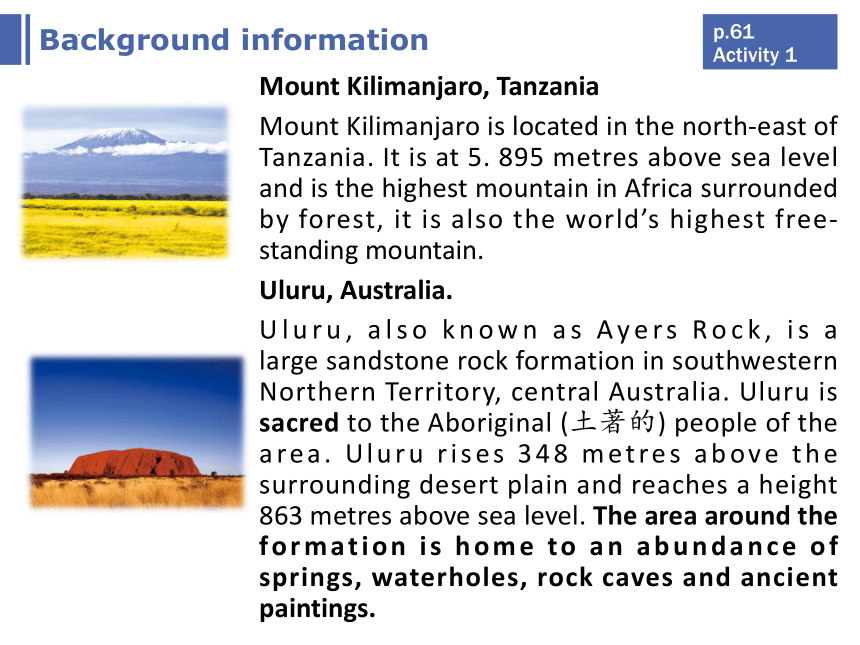
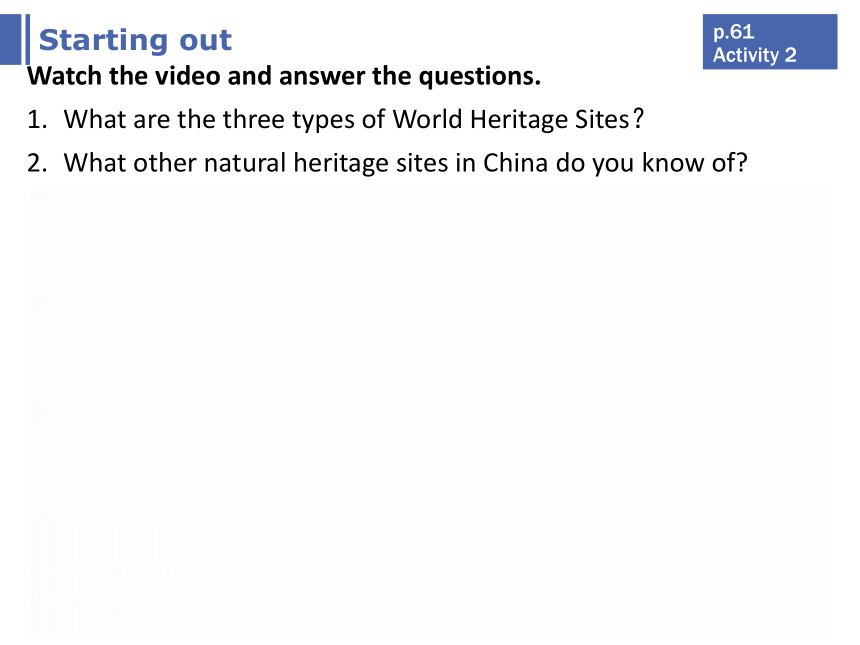
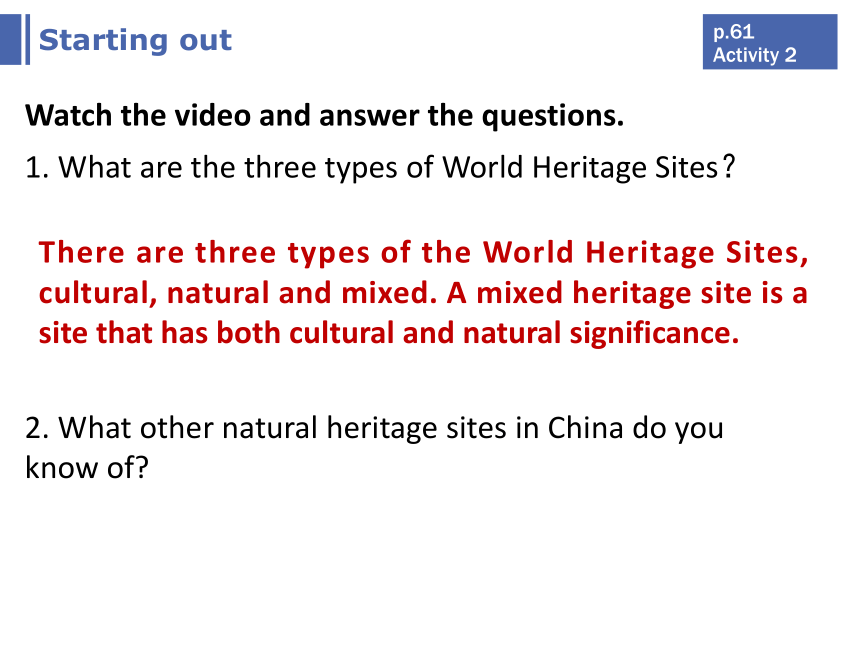
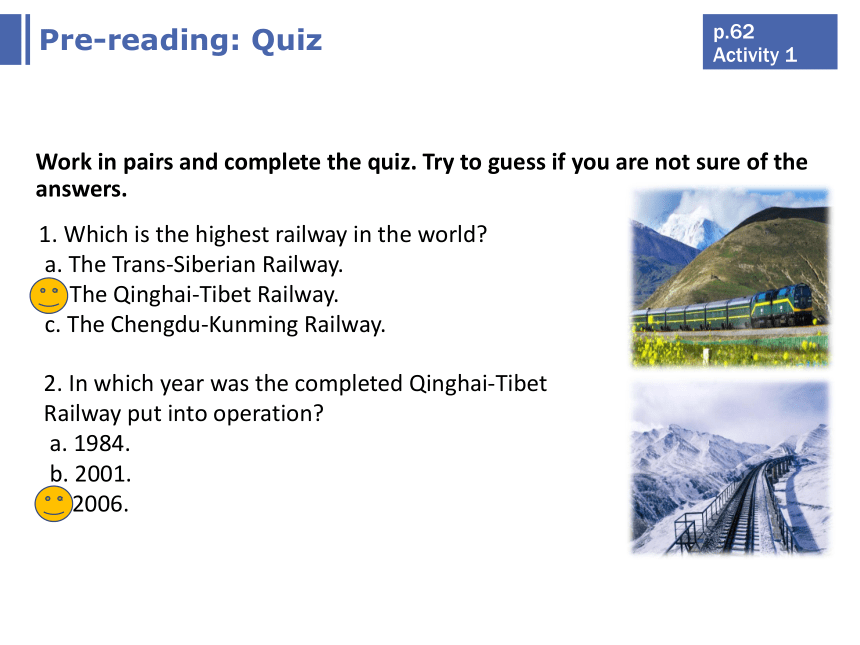
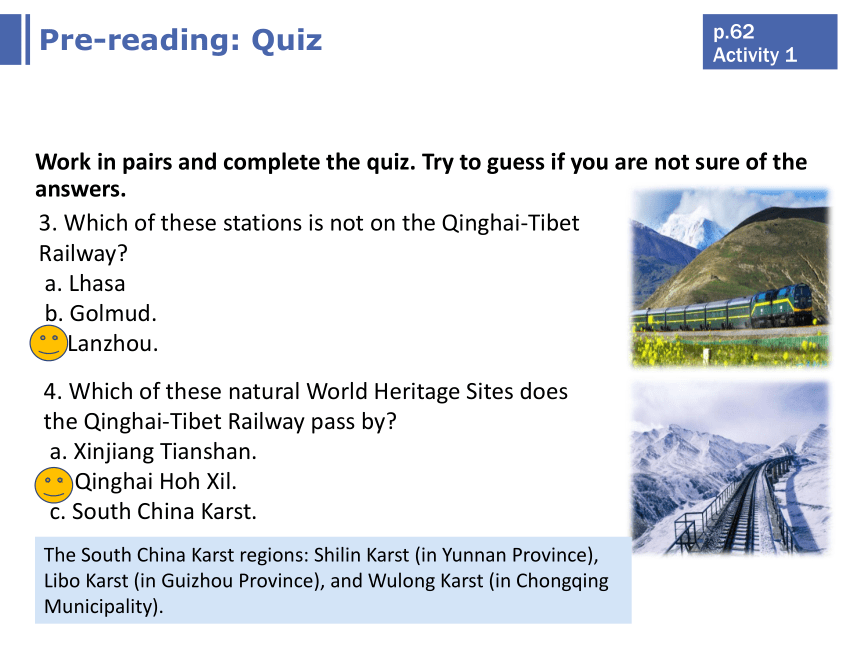

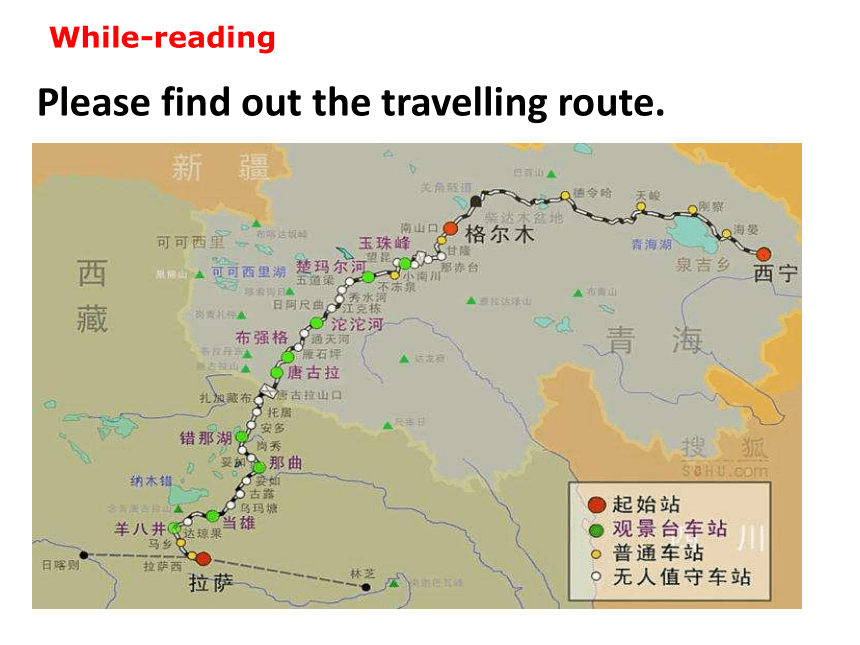
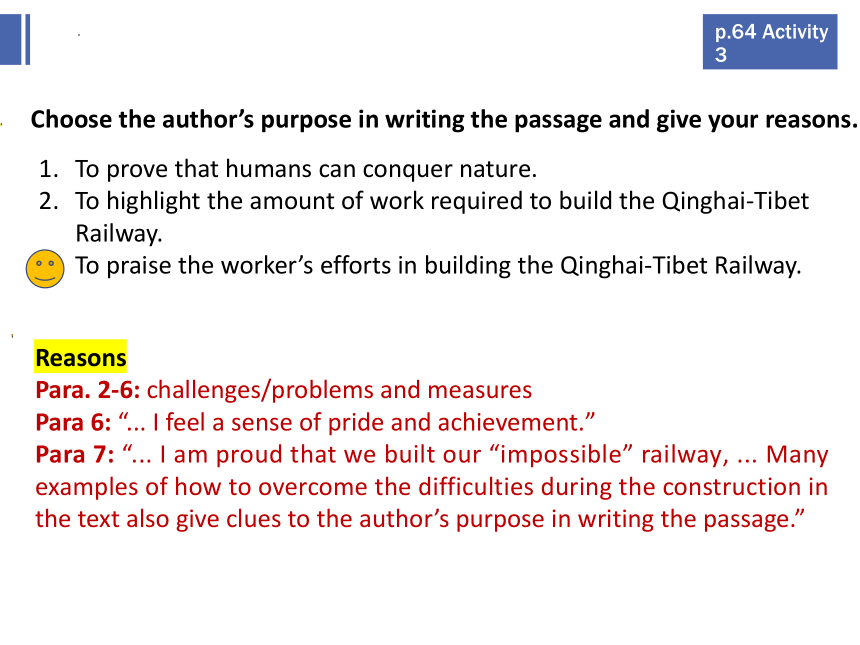
文档简介
(共31张PPT)
Nurturing nature
Book 4 Unit 6
Starting out & Understanding ideas
Starting out
Look at the pictures and answer the questions.
What do you know about these places
What do these places have in common?
p.61 Activity 1
Background information
Huanglong, China
Located in the north of Sichuan Province, Huanglong is a historic and scenic area widely known for its hot springs and waterfalls, valleys snow-capped peaks and forest. The area also has a population of endangered animals, Including pandas and monkeys.
Iguazu Falls, Argentina and Brazil
The Iguazú Falls stretch in width for 2.7 kilometres (or 1.7 miles). Their height varies between 60 metres (200 feet) and 82 metres (or 269 feet). They feature over 275 individual falls that thunder into the Iguazu River. Special walkways have been built around the Iguazu Falls to allow visitors to get close up to this wonder of their natural beauty and power.
p.61 Activity 1
Background information
Mount Kilimanjaro, Tanzania
Mount Kilimanjaro is located in the north-east of Tanzania. It is at 5. 895 metres above sea level and is the highest mountain in Africa surrounded by forest, it is also the world’s highest free-standing mountain.
Uluru, Australia.
Uluru, also known as Ayers Rock, is a large sandstone rock formation in southwestern Northern Territory, central Australia. Uluru is sacred to the Aboriginal (土著的) people of the area. Uluru rises 348 metres above the surrounding desert plain and reaches a height 863 metres above sea level. The area around the formation is home to an abundance of springs, waterholes, rock caves and ancient paintings.
p.61 Activity 1
Starting out
Watch the video and answer the questions.
What are the three types of World Heritage Sites?
What other natural heritage sites in China do you know of
p.61 Activity 2
Starting out
p.61 Activity 2
Watch the video and answer the questions.
1. What are the three types of World Heritage Sites?
2. What other natural heritage sites in China do you know of
There are three types of the World Heritage Sites, cultural, natural and mixed. A mixed heritage site is a site that has both cultural and natural significance.
Pre-reading: Quiz
Work in pairs and complete the quiz. Try to guess if you are not sure of the answers.
p.62 Activity 1
1. Which is the highest railway in the world
a. The Trans-Siberian Railway.
b. The Qinghai-Tibet Railway.
c. The Chengdu-Kunming Railway.
2. In which year was the completed Qinghai-Tibet Railway put into operation
a. 1984.
b. 2001.
c. 2006.
Pre-reading: Quiz
Work in pairs and complete the quiz. Try to guess if you are not sure of the answers.
p.62 Activity 1
3. Which of these stations is not on the Qinghai-Tibet Railway
a. Lhasa
b. Golmud.
c. Lanzhou.
4. Which of these natural World Heritage Sites does the Qinghai-Tibet Railway pass by
a. Xinjiang Tianshan.
b. Qinghai Hoh Xil.
c. South China Karst.
The South China Karst regions: Shilin Karst (in Yunnan Province), Libo Karst (in Guizhou Province), and Wulong Karst (in Chongqing Municipality).
Once believed “impossible”, the highest railway in the world is a record of the efforts of the workers to overcome the most difficult engineering challenges.
Prediction
What is the text about
p.62 Activity 2
Please find out the travelling route.
While-reading
To prove that humans can conquer nature.
To highlight the amount of work required to build the Qinghai-Tibet Railway.
To praise the worker’s efforts in building the Qinghai-Tibet Railway.
Choose the author’s purpose in writing the passage and give your reasons.
p.64 Activity 3
Reasons
Para. 2-6: challenges/problems and measures
Para 6: “... I feel a sense of pride and achievement.”
Para 7: “... I am proud that we built our “impossible” railway, ... Many examples of how to overcome the difficulties during the construction in the text also give clues to the author’s purpose in writing the passage.”
Organize information from the passage and complete the table.
p.64 Activity 4
Thirty-three passages
move safely and freely in their natural habitat
prevent damage to wetlands and grasslands
a total length of about 160 kilometres
moved to a new area
Several oxygen-making stations
regular breaks
protect Cuona Lake
build a twenty-kilometre wall
protect it from construction waste
Why is the Qinghai-Tibet Railway called the sky railway What other words could you think of to describe it
Key words:
impossible, highest, extraordinary...
Think and share
p.64
We can also say it is a miracle, great achievement...
2. How is the theme of nurturing nature presented in this text
Think and share
p.64
The author uses his personal experience to describe the challenges of building the railway and the solutions to these problems to tell us that we should protect nature while constructing and developing human society.
Language points
Useful expressions (p.61-p.63)
have … in common
put… into operation
work on
a record of
delicate ecosystem
be among the top concerns
catch one’s eyes
at one’s leisure
allow sb to do sth
speed past
有共同之处
投入使用
致力于…
对……的记录
脆弱的生态系统
是最关切的问题之一
吸引某人视线
在某人有空时
允许某人做某事
疾驰而过
Useful expressions (p.61-p.63)
______(sit) back in my seat, I can’t quite believe that I’m about to travel along the railway ________ many foreign experts _______ was “impossible”.
The train _______________(race) along _______ (steady) since it left Xining.
翻译:… “railways like massive dragons are winding among the mountains”…
一条条巨龙翻山越岭……
wind |wa nd| The river winds its way to the ocean.
4. _______ (take)years to complete, the Qinghai-Tibet Railway is a….
Sitting
that
claimed
has been racing
steadily
Taking
Useful expressions (p.63-p.64)
distinct ecosystem
fly by
before sb. know it
be located at/in/off…
UV radiation (ultraviolet)
present a challenge for…
oxygen-making stations
enjoy regular breaks
a sense of pride and achievement
protect sb / sth from sth
11.特殊的生态系统
12.飞逝
13.不知不觉地;很快
14.位于
15.紫外线
16.构成挑战
17.制氧站
18.享受有规律的休假
19.一种自豪感和成就感
20.保护某人 / 某事免受……
Useful expressions
be close to
reach out
wander the grasslands
bring … to life
thanks to our efforts
conquer nature
21.离得近
22.伸出(手……)
23.漫步草地
24.使……苏醒 / 焕发生机
25.多亏了我们的努力
26. 征服自然
5. In locations such as this, the thin air, __________ (change) weather and …
6. The Qinghai-Tibet Plateau ___________________ (attract) people’s ____________ (admire) for centuries.
7.It _______(true) is an extraordinary “Sky Railway”.
changeable
has been attracting
admiration
truly
Grammar
Present perfect continuous
Which of these statements is true about sentence (a)
Wild animals started using these passages in the past.
Wild animals used these passages only once.
Wild animals still use these passages now.
Activity 1
Look at the sentences from the reading passage and answer the questions.
Activity 1
Look at the sentences from the reading passage and answer the questions.
They are different in form and meaning.
sentence (a): the action is continuous from the past;
sentence (b): the action happened once in the past.
2. What is the difference between the expressions in bold in sentences (a) and (b)
现在完成进行时:概念界定
肯定:have / has been doing
否定:haven’t/hasn’t been doing
现在完成进行时表示动作从过去某一时间开始一直持续到现在,并且还可能继续进行。
1. 现在完成进行时的形式(Form)
2. 现在完成进行时的概念(Meaning)
1)在不用时间状语的情况下,have been doing的动作不一定已经完成(即强调延续), 而have done一般表示动作已经完成(即强调结果)。
例句分析:
He has been writing a novel, which will be finished next month.
He has written a novel, which is being prepared to come out now.
现在完成进行时
3. 现在完成进行时与现在完成时的区别
2)have been doing往往表示动作在重复,而have done一般不表示动作的重复。
例句分析:
I have been visiting my hometown recently, and it impresses
me differently each time.
最近我总回老家,每次感觉都不一样。
I have visited my hometown recently, whose changes have
left a deep impression on me.
最近我回了趟老家,那里巨大的变化让我惊讶。
现在完成进行时
3. 现在完成进行时与现在完成时的区别
3)have been doing与所有进行时态一样带有感彩,可使表达显得生动;而现在完成时往往只表明一个事实、一种影响或结果,不带感彩。
例如:
Recently he has always been helping me.
最近他总帮我(感激 )。
Recently he has helped me a lot.
最近他帮了我很多(客观陈述)。
现在完成进行时
3. 现在完成进行时与现在完成时的区别
1.Mary really hard on his book and thinks he’ll have finished it by Friday. (2015陕西22)
worked B. has been working
C. had worked D. has worked
2.—Where is Peter I can't find him anywhere.
—He went to the library after breakfast and _____ his essay there ever since. (2015福建30)
wrote B. had written
C. has been writing D. is writing
Practice: Activity 2 (教材p.65)
1. have been hearing
2. has been making
3. is moving
4. have been flying
5. have been given
6. have been using
Practice: Activity 3 (教材p.65)
Look at the charts and make sentences using the present perfect continuous tense.
1. The number of trees has been increasing in the last 20 years.
2. Desert areas have been reducing in the last 20 years.
3. Butterfly population has been increasing / has been becoming larger and larger in the last 20 years.
Nurturing nature
Book 4 Unit 6
Starting out & Understanding ideas
Starting out
Look at the pictures and answer the questions.
What do you know about these places
What do these places have in common?
p.61 Activity 1
Background information
Huanglong, China
Located in the north of Sichuan Province, Huanglong is a historic and scenic area widely known for its hot springs and waterfalls, valleys snow-capped peaks and forest. The area also has a population of endangered animals, Including pandas and monkeys.
Iguazu Falls, Argentina and Brazil
The Iguazú Falls stretch in width for 2.7 kilometres (or 1.7 miles). Their height varies between 60 metres (200 feet) and 82 metres (or 269 feet). They feature over 275 individual falls that thunder into the Iguazu River. Special walkways have been built around the Iguazu Falls to allow visitors to get close up to this wonder of their natural beauty and power.
p.61 Activity 1
Background information
Mount Kilimanjaro, Tanzania
Mount Kilimanjaro is located in the north-east of Tanzania. It is at 5. 895 metres above sea level and is the highest mountain in Africa surrounded by forest, it is also the world’s highest free-standing mountain.
Uluru, Australia.
Uluru, also known as Ayers Rock, is a large sandstone rock formation in southwestern Northern Territory, central Australia. Uluru is sacred to the Aboriginal (土著的) people of the area. Uluru rises 348 metres above the surrounding desert plain and reaches a height 863 metres above sea level. The area around the formation is home to an abundance of springs, waterholes, rock caves and ancient paintings.
p.61 Activity 1
Starting out
Watch the video and answer the questions.
What are the three types of World Heritage Sites?
What other natural heritage sites in China do you know of
p.61 Activity 2
Starting out
p.61 Activity 2
Watch the video and answer the questions.
1. What are the three types of World Heritage Sites?
2. What other natural heritage sites in China do you know of
There are three types of the World Heritage Sites, cultural, natural and mixed. A mixed heritage site is a site that has both cultural and natural significance.
Pre-reading: Quiz
Work in pairs and complete the quiz. Try to guess if you are not sure of the answers.
p.62 Activity 1
1. Which is the highest railway in the world
a. The Trans-Siberian Railway.
b. The Qinghai-Tibet Railway.
c. The Chengdu-Kunming Railway.
2. In which year was the completed Qinghai-Tibet Railway put into operation
a. 1984.
b. 2001.
c. 2006.
Pre-reading: Quiz
Work in pairs and complete the quiz. Try to guess if you are not sure of the answers.
p.62 Activity 1
3. Which of these stations is not on the Qinghai-Tibet Railway
a. Lhasa
b. Golmud.
c. Lanzhou.
4. Which of these natural World Heritage Sites does the Qinghai-Tibet Railway pass by
a. Xinjiang Tianshan.
b. Qinghai Hoh Xil.
c. South China Karst.
The South China Karst regions: Shilin Karst (in Yunnan Province), Libo Karst (in Guizhou Province), and Wulong Karst (in Chongqing Municipality).
Once believed “impossible”, the highest railway in the world is a record of the efforts of the workers to overcome the most difficult engineering challenges.
Prediction
What is the text about
p.62 Activity 2
Please find out the travelling route.
While-reading
To prove that humans can conquer nature.
To highlight the amount of work required to build the Qinghai-Tibet Railway.
To praise the worker’s efforts in building the Qinghai-Tibet Railway.
Choose the author’s purpose in writing the passage and give your reasons.
p.64 Activity 3
Reasons
Para. 2-6: challenges/problems and measures
Para 6: “... I feel a sense of pride and achievement.”
Para 7: “... I am proud that we built our “impossible” railway, ... Many examples of how to overcome the difficulties during the construction in the text also give clues to the author’s purpose in writing the passage.”
Organize information from the passage and complete the table.
p.64 Activity 4
Thirty-three passages
move safely and freely in their natural habitat
prevent damage to wetlands and grasslands
a total length of about 160 kilometres
moved to a new area
Several oxygen-making stations
regular breaks
protect Cuona Lake
build a twenty-kilometre wall
protect it from construction waste
Why is the Qinghai-Tibet Railway called the sky railway What other words could you think of to describe it
Key words:
impossible, highest, extraordinary...
Think and share
p.64
We can also say it is a miracle, great achievement...
2. How is the theme of nurturing nature presented in this text
Think and share
p.64
The author uses his personal experience to describe the challenges of building the railway and the solutions to these problems to tell us that we should protect nature while constructing and developing human society.
Language points
Useful expressions (p.61-p.63)
have … in common
put… into operation
work on
a record of
delicate ecosystem
be among the top concerns
catch one’s eyes
at one’s leisure
allow sb to do sth
speed past
有共同之处
投入使用
致力于…
对……的记录
脆弱的生态系统
是最关切的问题之一
吸引某人视线
在某人有空时
允许某人做某事
疾驰而过
Useful expressions (p.61-p.63)
______(sit) back in my seat, I can’t quite believe that I’m about to travel along the railway ________ many foreign experts _______ was “impossible”.
The train _______________(race) along _______ (steady) since it left Xining.
翻译:… “railways like massive dragons are winding among the mountains”…
一条条巨龙翻山越岭……
wind |wa nd| The river winds its way to the ocean.
4. _______ (take)years to complete, the Qinghai-Tibet Railway is a….
Sitting
that
claimed
has been racing
steadily
Taking
Useful expressions (p.63-p.64)
distinct ecosystem
fly by
before sb. know it
be located at/in/off…
UV radiation (ultraviolet)
present a challenge for…
oxygen-making stations
enjoy regular breaks
a sense of pride and achievement
protect sb / sth from sth
11.特殊的生态系统
12.飞逝
13.不知不觉地;很快
14.位于
15.紫外线
16.构成挑战
17.制氧站
18.享受有规律的休假
19.一种自豪感和成就感
20.保护某人 / 某事免受……
Useful expressions
be close to
reach out
wander the grasslands
bring … to life
thanks to our efforts
conquer nature
21.离得近
22.伸出(手……)
23.漫步草地
24.使……苏醒 / 焕发生机
25.多亏了我们的努力
26. 征服自然
5. In locations such as this, the thin air, __________ (change) weather and …
6. The Qinghai-Tibet Plateau ___________________ (attract) people’s ____________ (admire) for centuries.
7.It _______(true) is an extraordinary “Sky Railway”.
changeable
has been attracting
admiration
truly
Grammar
Present perfect continuous
Which of these statements is true about sentence (a)
Wild animals started using these passages in the past.
Wild animals used these passages only once.
Wild animals still use these passages now.
Activity 1
Look at the sentences from the reading passage and answer the questions.
Activity 1
Look at the sentences from the reading passage and answer the questions.
They are different in form and meaning.
sentence (a): the action is continuous from the past;
sentence (b): the action happened once in the past.
2. What is the difference between the expressions in bold in sentences (a) and (b)
现在完成进行时:概念界定
肯定:have / has been doing
否定:haven’t/hasn’t been doing
现在完成进行时表示动作从过去某一时间开始一直持续到现在,并且还可能继续进行。
1. 现在完成进行时的形式(Form)
2. 现在完成进行时的概念(Meaning)
1)在不用时间状语的情况下,have been doing的动作不一定已经完成(即强调延续), 而have done一般表示动作已经完成(即强调结果)。
例句分析:
He has been writing a novel, which will be finished next month.
He has written a novel, which is being prepared to come out now.
现在完成进行时
3. 现在完成进行时与现在完成时的区别
2)have been doing往往表示动作在重复,而have done一般不表示动作的重复。
例句分析:
I have been visiting my hometown recently, and it impresses
me differently each time.
最近我总回老家,每次感觉都不一样。
I have visited my hometown recently, whose changes have
left a deep impression on me.
最近我回了趟老家,那里巨大的变化让我惊讶。
现在完成进行时
3. 现在完成进行时与现在完成时的区别
3)have been doing与所有进行时态一样带有感彩,可使表达显得生动;而现在完成时往往只表明一个事实、一种影响或结果,不带感彩。
例如:
Recently he has always been helping me.
最近他总帮我(感激 )。
Recently he has helped me a lot.
最近他帮了我很多(客观陈述)。
现在完成进行时
3. 现在完成进行时与现在完成时的区别
1.Mary really hard on his book and thinks he’ll have finished it by Friday. (2015陕西22)
worked B. has been working
C. had worked D. has worked
2.—Where is Peter I can't find him anywhere.
—He went to the library after breakfast and _____ his essay there ever since. (2015福建30)
wrote B. had written
C. has been writing D. is writing
Practice: Activity 2 (教材p.65)
1. have been hearing
2. has been making
3. is moving
4. have been flying
5. have been given
6. have been using
Practice: Activity 3 (教材p.65)
Look at the charts and make sentences using the present perfect continuous tense.
1. The number of trees has been increasing in the last 20 years.
2. Desert areas have been reducing in the last 20 years.
3. Butterfly population has been increasing / has been becoming larger and larger in the last 20 years.
